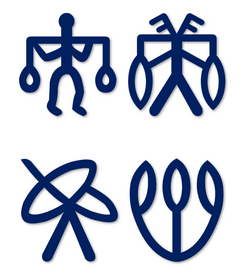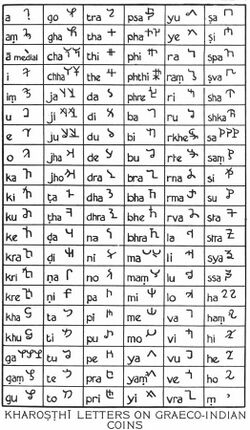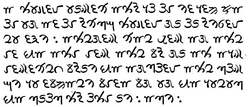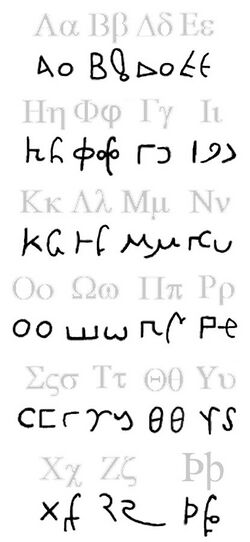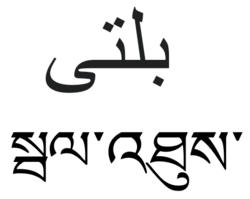Biology:Pre-Islamic scripts of Pakistan
Pakistan has a rich linguistic history prior to Islamic conquests of 7th century. Unlike other parts of Indian subcontinent where scripts derived from Brahmi script were used, in Pakistan multiple indigenous scripts like Indus script and Kharosthi script were developed, which spread to the neighbouring countries. Following is the list of pre-Islamic scripts that were used to write native languages in some point of Pakistan 's history;
Indus script
The Indus script (also known as the Harappan script) is a corpus of symbols produced by the Indus Valley Civilization, in Harrapa and Kot Diji in modern day's Pakistan .
Most inscriptions containing these symbols are extremely short, making it difficult to judge whether or not these symbols constituted a script used to record a language, or even symbolise a writing system.[1] In spite of many attempts,[2] the 'script' has not yet been deciphered, but efforts are ongoing. It was used during time period of 2700–1900 BCE[3][4][5]
Kharosthi script
The Kharosthi script, also spelled Kharoshthi or Kharoṣṭhī (Kharosthi: 𐨑𐨪𐨆𐨯𐨠𐨁) [6] was an ancient script used in Gandhara (now Pakistan and north-eastern Afghanistan)[7] to write Gandhari Prakrit and Sanskrit. It was used in Central Asia as well.[7] An abugida, it was introduced at least by the middle of the 3rd century BCE, possibly during the 4th century BCE,[8] and remained in use until it died out in its homeland around the 3rd century CE.[7]
It was also in use in Bactria, the Kushan Empire, Sogdia, and along the Silk Road. There is some evidence it may have survived until the 7th century in Khotan and Niya, both cities in Xinjiang.
Sharada script
The Śāradā, Sarada or Sharada script is an abugida writing system of the Brahmic family of scripts. The script was widespread between the 8th and 12th centuries in the northwestern parts of Indian Subcontinent (in Kashmir and northern KPK), for writing Sanskrit and Kashmiri.[9][10][11] Originally more widespread, its use became later restricted to Kashmir, and it is now rarely used except by the Kashmiri Pandit community for religious purposes.
Landa script
Laṇḍā script evolved from the Śāradā during the 10th century. It was widely used in the northern and north-western part of Pakistan in the area comprising Punjab, Sindh, Kashmir and some parts of Balochistan and Khyber Pakhtunkhwa. It was used to write Punjabi, Hindustani, Sindhi, Saraiki, Balochi, Kashmiri, Pashto, and various Punjabi dialects like Pahari-Pothwari.
Sub-scripts of landa script
Landa script gave rise to many important descendant writing systems like;
Multani script
Multani is a Brahmic script originating in the Multan region of Punjab and in northern Sindh, Pakistan. It was used to write Saraiki language, often considered a dialect of Western Punjabi language. The script was used for routine writing and commercial activities. Multani is one of four Landa scripts whose usage was extended beyond the mercantile domain and formalized for literary activity and printing; the others being Gurmukhi, Khojki, and Khudawadi.
Mahajani script
Mahajani is a Laṇḍā mercantile script that was historically used in Pakistan for writing accounts and financial records in Marwari, Hindi and Punjabi.[12] It is a Brahmic script and is written left-to-right. Mahajani refers to the Hindi word for 'bankers', also known as 'sarrafi' or 'kothival' (merchant).
Khojki script
Khojki, or Khojiki (Urdu: خوجكى; Sindhi: خوجڪي (Arabic script) खोजकी (Devanagari)), is a script used formerly and almost exclusively by the Khoja community of parts of the Pakistan such as Sindh. The name "Khojki" is derived from the Persian word khoje, which means "master", or "lord". It was employed primarily to record Isma'ili religious literature as well as literature for a few secret Twelver sects. It is one of the two Landa scripts used for liturgy, the other being the Gurmukhī alphabet
Khudabadi script
Khudabadi (𑊻𑋩𑋣𑋏𑋠𑋔𑋠𑋏𑋢) is a script generally used by some Sindhis to write the Sindhi language. It is also known as Hathvanki (or Warangi) script. Khudabadi is one of the four scripts used for writing the Sindhi language, the others being Perso-Arabic, Khojki and Devanagari script.
Other scripts
Other important scripts that have been used for writing purposes in Pakistan include;
Bactrian script
Bactrian (Αριαο, Aryao, [arjaː]) is an extinct language formerly spoken in the region of Bactria (in the north of Pakistan )[13] and was used as the official language of the Indo-Greek kingdom, Kushan, and the Hephthalite empires in the region of modern day's Pakistan .
Brahmi script
Brahmi (/ˈbrɑːmi/; ISO 15919: Brāhmī ) is the modern name[14] for a writing system of ancient South Asia. It latter gave rise of Sharada, Landa and other script used in Pakistan.
Pahlavi script
During rule of Persian empires in parts of Balochistan, various Pahlavi scripts may have been used there as a writing system.
Tibetan script
Originally more widespread in northern areas, now only Balti language is written using this script.
References
- ↑ Locklear, Mallory (January 25, 2017). "Science: Machine learning could finally crack the 4,000-year-old Indus script". The Verge. Manhattan, New York, NY: Vox Media. https://www.theverge.com/2017/1/25/14371450/indus-valley-civilization-ancient-seals-symbols-language-algorithms-ai. "After a century of failing to crack an ancient script, linguists turn to machines."
- ↑ (Possehl, 1996)
- ↑ David Whitehouse (May 4, 1999). "'Earliest writing' found". http://news.bbc.co.uk/2/hi/sci/tech/334517.stm.
- ↑ "Evidence for Indus script dated to ca. 3500 BCE". http://www.docstoc.com/docs/95980790/Evidence-for-Indus-script-dated-to-ca-3500-BCE.
- ↑ Edwin Bryant. The Quest for the Origins of Vedic Culture: The Indo-Aryan Migration Debate. Oxford University. p. 178.
- ↑ "When these alphabets were first deciphered, scholars gave them different names such as 'Indian-Pali' for Brahmi and 'Arian-Pali' for Kharosthi, but these terms are no longer in use." in Upāsaka, Sī Esa; Mahāvihāra, Nava Nālandā (2002) (in en). History of palæography of Mauryan Brāhmī script. Nava Nālanda Mahāvihāra. p. 6. ISBN 9788188242047. https://books.google.com/books?id=P19jAAAAMAAJ.
- ↑ 7.0 7.1 7.2 R. D. Banerji (April 1920). "The Kharosthi Alphabet". The Journal of the Royal Asiatic Society of Great Britain and Ireland 52 (2): 193–219. doi:10.1017/S0035869X0014794X.
- ↑ Salomon 1998, pp. 11–13.
- ↑ Selin, Helaine (2008) (in en). Encyclopaedia of the History of Science, Technology, and Medicine in Non-Western Cultures. Springer Science & Business Media. p. Bakhshali Manuscript entry. ISBN 9781402045592. Bibcode: 2008ehst.book.....S. https://books.google.com/books?id=kt9DIY1g9HYC&pg=RA1-PA1.
- ↑ Singh, Upinder (2008) (in en). A History of Ancient and Early Medieval India: From the Stone Age to the 12th Century. Pearson Education India. p. 43. ISBN 9788131711200. https://books.google.com/books?id=H3lUIIYxWkEC&pg=PA43.
- ↑ Sir George Grierson. (1916). "On the Sharada Alphabet". Journal of the Royal Asiatic Society, 17.
- ↑ Pandey, Anshuman (2011-07-12). "N4126: Proposal to Encode the Mahajani Script in ISO/IEC 10646". Working Group Document, ISO/IEC JTC1/SC2/WG2. https://www.unicode.org/L2/L2011/11274-n4126-mahajani.pdf.
- ↑ Sims-Williams, N. "Bactrian Language". http://www.iranicaonline.org/articles/bactrian-language.
- ↑ Salomon 1998, p. 17 Quote: " Until the late nineteenth century, the script of the Aśokan (non-Kharosthi) inscriptions and its immediate derivatives was referred to by various names such as “lath” or “Lat,” “Southern Aśokan,” “Indian Pali,” “Mauryan,” and so on. The application to it of the name Brahmi [sc. lipi], which stands at the head of the Buddhist and Jaina script lists, was first suggested by T[errien] de Lacouperie, who noted that in the Chinese Buddhist encyclopedia Fa yiian chu lin the scripts whose names corresponded to the Brahmi and Kharosthi of the Lalitavistara are described as written from left to right and from right to left, respectively. He therefore suggested that the name Brahmi should refer to the left-to-right “Indo-Pali” script of the Aśokan pillar inscriptions, and Kharosthi to the right-to-left “Bactro-Pali” script of the rock inscriptions from the northwest."
